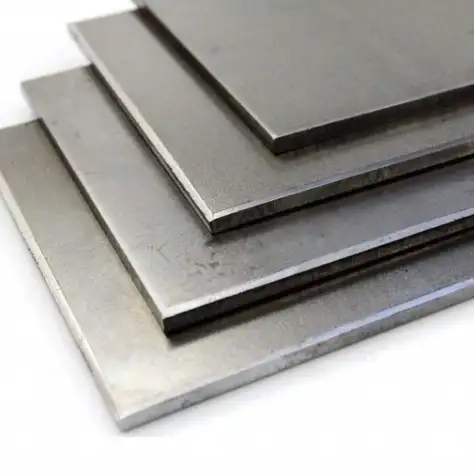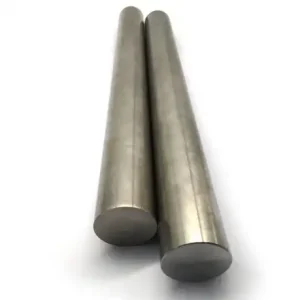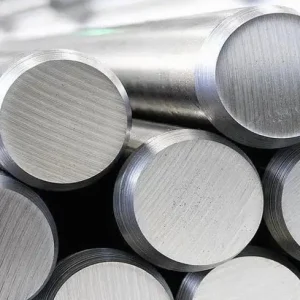Low carbon steel plates represent one of the most versatile and economically viable materials in contemporary industrial applications. These plates, containing less than 0.30% carbon content, offer exceptional formability, weldability, and machinability while maintaining adequate strength for numerous structural and manufacturing purposes. At MWalloys, we have witnessed firsthand how these materials serve as the backbone of construction, automotive, shipbuilding, and general engineering industries worldwide.
What is a Low Carbon Steel Plate?
Low carbon steel plates are flat-rolled steel products characterized by their minimal carbon content, typically ranging from 0.05% to 0.30%. We classify these materials based on their exceptional ductility and malleability, which make them ideal for applications requiring extensive forming operations.
The fundamental structure consists primarily of ferrite with minimal pearlite phases. This microstructural composition provides the material with its characteristic soft, workable nature. Unlike their higher carbon counterparts, these plates exhibit superior cold-forming capabilities without significant work hardening.
Manufacturing processes involve hot rolling or cold rolling techniques, depending on the intended application requirements. Hot-rolled variants offer better formability for structural applications, while cold-rolled versions provide enhanced surface finish and dimensional accuracy.
What is the Chemical Composition of Low Carbon Steel Plate?
The chemical composition directly influences the mechanical properties and performance characteristics of low carbon steel plates. We maintain strict quality control over these elemental percentages to ensure consistent performance.
| Element | Percentage Range | Function |
|---|---|---|
| Carbon (C) | 0.05-0.30% | Provides strength and hardness |
| Manganese (Mn) | 0.30-1.50% | Improves strength and hardenability |
| Silicon (Si) | 0.10-0.35% | Acts as deoxidizer and strengthener |
| Phosphorus (P) | ≤0.040% | Controlled for ductility maintenance |
| Sulfur (S) | ≤0.040% | Minimized to prevent hot shortness |
| Iron (Fe) | Balance | Primary base metal |
| Aluminum (Al) | 0.015-0.065% | Grain refining agent |
| Nitrogen (N) | ≤0.012% | Controlled for formability |
The precise balance of these elements determines the final properties. Manganese content particularly affects the strength-to-ductility ratio, while silicon contributes to the steel's ability to be effectively deoxidized during production.
What are the Mechanical Properties of Low Carbon Steel Plate?
Mechanical properties vary depending on the specific grade and processing conditions. These characteristics make low carbon steel plates suitable for diverse applications requiring different performance criteria.
| Property | Typical Range | Unit | Testing Standard |
|---|---|---|---|
| Tensile Strength | 300-500 | MPa | ASTM A370 |
| Yield Strength | 180-350 | MPa | ASTM A370 |
| Elongation | 20-35 | % | ASTM A370 |
| Hardness (HRB) | 55-85 | HRB | ASTM E18 |
| Impact Energy (Charpy V-notch) | 27-100 | J | ASTM A370 |
| Modulus of Elasticity | 200 | GPa | ASTM E111 |
| Poisson's Ratio | 0.27-0.30 | - | ASTM E132 |
| Fatigue Strength | 160-200 | MPa | ASTM D7791 |
These properties demonstrate the material's excellent balance between strength and ductility. The relatively low yield strength allows for easy forming operations, while adequate tensile strength ensures structural integrity in service conditions.
What is the Specification of Low Carbon Steel Plate?
International specifications govern the production and quality requirements for low carbon steel plates. We adhere to multiple standards to serve global markets effectively.
| Standard | Region | Grade Examples | Thickness Range |
|---|---|---|---|
| ASTM A36 | USA | A36 | 6-200mm |
| ASTM A283 | USA | Grade A, B, C, D | 1.5-150mm |
| EN 10025 | Europe | S235JR, S275JR | 3-250mm |
| JIS G3101 | Japan | SS330, SS400 | 1.6-200mm |
| GB/T 700 | China | Q235A, Q235B | 2-300mm |
| IS 2062 | India | E250A, E250B | 5-160mm |
| DIN 17100 | Germany | St37-2, St44-2 | 3-200mm |
| BS 4360 | UK | Grade 40A, 43A | 6-150mm |
Each specification defines particular chemical composition limits, mechanical property requirements, and testing procedures. The selection depends on the intended application and regional regulatory requirements.
What does Low Carbon Steel Plate stand for?
Low carbon steel plates represent the fundamental building blocks of modern infrastructure and manufacturing. The terminology "low carbon" specifically refers to the carbon content being maintained below 0.30%, which distinguishes these materials from medium carbon (0.30-0.60%) and high carbon (0.60-2.0%) steel variants.
This designation carries significant implications for material behavior. Lower carbon content translates to enhanced weldability, formability, and machinability. The material exhibits excellent cold-working properties, making it suitable for applications requiring extensive deformation without cracking or excessive work hardening.
From a metallurgical perspective, low carbon content ensures minimal carbide formation, resulting in a predominantly ferritic microstructure. This structure provides the characteristic soft, ductile behavior that makes these plates so versatile in industrial applications.
What is the difference between Low Carbon Steel Plate and High Carbon Steel Plate?
The fundamental differences between low and high carbon steel plates stem from their carbon content and resulting properties. These variations significantly impact their respective applications and processing requirements.
| Property | Low Carbon Steel | High Carbon Steel |
|---|---|---|
| Carbon Content | 0.05-0.30% | 0.60-2.00% |
| Hardness | 55-85 HRB | 45-65 HRC |
| Tensile Strength | 300-500 MPa | 800-1400 MPa |
| Ductility | Excellent | Limited |
| Weldability | Excellent | Poor |
| Formability | Excellent | Limited |
| Machinability | Good | Moderate |
| Heat Treatment Response | Minimal | Excellent |
| Cost | Lower | Higher |
| Applications | Structural, General | Tools, Springs |
High carbon variants offer superior strength and hardness but sacrifice ductility and weldability. This trade-off makes them suitable for cutting tools and wear-resistant applications but unsuitable for structural purposes requiring extensive forming operations.
What is Low Carbon Steel Plate used for?
Low carbon steel plates find applications across numerous industries due to their versatile properties and economic advantages. We observe consistent demand across several key sectors.
Construction and Infrastructure: Structural frameworks, bridge components, building facades, and reinforcement applications benefit from the material's weldability and formability. The ability to create complex shapes while maintaining structural integrity makes these plates indispensable for modern construction projects.
Automotive Industry: Body panels, chassis components, and structural reinforcements utilize low carbon steel's excellent formability. The material's ability to undergo deep drawing operations makes it ideal for automotive body manufacturing.
Shipbuilding: Hull construction, deck plating, and bulkhead applications require materials that can withstand marine environments while offering good weldability for assembly operations.
General Engineering: Pressure vessels, storage tanks, and machinery components benefit from the material's balanced properties and ease of fabrication.
Appliance Manufacturing: White goods production relies heavily on low carbon steel's formability for creating complex shapes in washing machines, refrigerators, and other household appliances.
What is the classification of Low Carbon Steel Plate?
Classification systems organize low carbon steel plates based on various criteria including intended use, quality level, and specific property requirements.
| Classification Type | Categories | Characteristics |
|---|---|---|
| By Carbon Content | Ultra Low (≤0.08%), Low (0.08-0.30%) | Formability variations |
| By Quality Level | Commercial, Drawing, Deep Drawing | Increasing formability |
| By Surface Finish | Hot Rolled, Cold Rolled, Galvanized | Different surface conditions |
| By Strength Level | Regular Strength, High Strength | Yield strength variations |
| By Application | Structural, Automotive, General Purpose | Specific property optimization |
| By Forming Capability | Standard, Extra Deep Drawing | Formability classifications |
| By Coating | Bare, Galvanized, Painted | Corrosion protection levels |
Each classification serves specific market requirements. Deep drawing grades require exceptional formability with minimal inclusion content, while structural grades prioritize strength and weldability characteristics.
What is Low Carbon Steel grades?
Low carbon steel grades represent standardized material specifications that define chemical composition, mechanical properties, and quality requirements. We work with various international grade systems to meet diverse customer requirements.
ASTM Grades: A36 remains the most common structural grade, offering 250 MPa minimum yield strength. A283 grades (A, B, C, D) provide increasing strength levels for pressure vessel applications.
European Standards: S235JR and S275JR represent typical structural grades with guaranteed impact properties. The "JR" designation indicates room temperature impact testing requirements.
Chinese Standards: Q235A and Q235B grades dominate the Chinese market, with "A" and "B" indicating different deoxidation practices and impurity levels.
Japanese Standards: SS400 and SS330 grades serve structural applications with specific requirements for surface quality and dimensional tolerances.
Grade selection depends on specific application requirements including strength needs, forming requirements, and environmental conditions. We assist customers in selecting appropriate grades based on their technical specifications and cost considerations.
Low Carbon Steel Plate Global Market Prices 2025
Market pricing for low carbon steel plates fluctuates based on raw material costs, supply-demand dynamics, and regional economic conditions. Current pricing reflects global steel market trends and production capacity utilization.
| Region | Price Range (USD/MT) | Market Conditions | Key Factors |
|---|---|---|---|
| China | 450-550 | Stable supply | Production capacity, export policies |
| United States | 650-750 | Moderate demand | Infrastructure spending, tariff impacts |
| Europe | 600-700 | Variable demand | Energy costs, environmental regulations |
| India | 500-600 | Growing demand | Infrastructure development |
| Japan | 700-800 | Stable market | High quality requirements |
| Southeast Asia | 550-650 | Increasing demand | Economic growth, construction boom |
| Middle East | 600-700 | Project-driven | Oil revenues, construction projects |
| Brazil | 580-680 | Recovery phase | Economic stabilization |
These prices reflect FOB mill pricing for standard grades and thicknesses. Actual transaction prices may vary based on order quantities, delivery terms, and specific grade requirements.
Low Carbon Steel Plate Sizes and Weight Parameters
Standard dimensions and weight calculations are crucial for project planning and transportation considerations. We maintain comprehensive inventory across standard sizes to meet immediate delivery requirements.
| Thickness (mm) | Width (mm) | Length (mm) | Weight (kg/m²) | Common Applications |
|---|---|---|---|---|
| 3 | 1000-2000 | 2000-12000 | 23.55 | Sheet metal work |
| 6 | 1200-2500 | 3000-12000 | 47.1 | General fabrication |
| 10 | 1500-3000 | 6000-12000 | 78.5 | Structural components |
| 16 | 1500-3000 | 6000-12000 | 125.6 | Heavy fabrication |
| 20 | 1500-3000 | 6000-12000 | 157.0 | Structural applications |
| 25 | 1500-3000 | 6000-12000 | 196.25 | Heavy structural |
| 32 | 1500-3000 | 6000-12000 | 251.2 | Pressure vessels |
| 40 | 1500-3000 | 6000-12000 | 314.0 | Heavy industrial |
Weight calculations use the standard steel density of 7.85 g/cm³. Custom sizes are available based on specific project requirements, with consideration for rolling mill capabilities and transportation constraints.
Advantages of Low Carbon Steel Plate
Low carbon steel plates offer numerous advantages that make them the preferred choice for many industrial applications. These benefits stem from their unique combination of properties and economic considerations.
Economic Benefits: Cost-effectiveness represents the primary advantage. Lower alloying element content reduces raw material costs, while simplified processing requirements minimize manufacturing expenses.
Processing Advantages: Excellent weldability allows for complex assemblies without preheating or post-weld heat treatment requirements. Superior formability enables complex shapes through stamping, bending, and deep drawing operations.
Mechanical Properties: The optimal balance between strength and ductility provides adequate structural performance while maintaining workability for fabrication operations.
Surface Quality: Good surface finish characteristics make these plates suitable for applications requiring painting or coating without extensive surface preparation.
Availability: Widespread production and standardization ensure consistent supply and competitive pricing across global markets.
Recyclability: Environmental benefits include high recyclability and reduced energy requirements for production compared to higher alloy steels.
Manufacturing Process Flow
The production of low carbon steel plates involves multiple stages, each critical to achieving desired properties and quality standards. We oversee the entire process to ensure consistent quality delivery.
Raw Material Preparation: Iron ore, coal, and recycled steel undergo preparation and charging into blast furnaces. The ratio of these materials affects the final chemical composition.
Primary Steelmaking: Basic oxygen furnace (BOF) or electric arc furnace (EAF) processes convert raw materials into liquid steel. Carbon content adjustment occurs during this stage through controlled oxidation.
Secondary Refining: Ladle metallurgy stations fine-tune chemical composition and remove impurities. Degassing processes eliminate hydrogen and nitrogen to improve mechanical properties.
Continuous Casting: Liquid steel solidifies into slabs through continuous casting machines. This process controls grain structure and minimizes segregation.
Reheating and Rolling: Slabs undergo reheating in walking beam furnaces before hot rolling. Multiple rolling passes reduce thickness while controlling microstructure development.
Cooling and Coiling: Controlled cooling rates influence final mechanical properties. Coiling temperature affects the ferritic-pearlitic microstructure balance.
Quality Control: Comprehensive testing including chemical analysis, mechanical testing, and dimensional verification ensures specification compliance.
Qatar Procurement Case Study
We recently completed a significant supply contract for Qatar's infrastructure development projects, demonstrating our capability to meet large-scale international requirements.
Project Scope: The contract involved supplying 15,000 metric tons of low carbon steel plates for stadium construction and infrastructure projects related to major sporting events.
Technical Requirements: Specifications called for ASTM A36 and A283 Grade C materials with enhanced impact properties for outdoor structural applications in extreme climate conditions.
Challenges Addressed: Desert climate considerations required special attention to surface preparation and packaging. We implemented enhanced rust preventive measures and modified packaging protocols for long-term storage.
Quality Assurance: Third-party inspection by internationally recognized agencies verified all materials met specifications. Charpy impact testing at elevated temperatures ensured performance in Qatar's climate conditions.
Logistics Solutions: Coordinated shipping schedules with project timelines required careful planning. We established temporary storage facilities to ensure continuous supply during peak construction phases.
Results: All deliveries met scheduled timelines with zero quality rejections. The project established MWalloys as a reliable supplier for Middle Eastern infrastructure projects.
This case demonstrates our ability to handle complex international projects while maintaining quality standards and delivery commitments. The success led to additional contracts in the region and strengthened our position in Middle Eastern markets.
Frequently Asked Questions
Q1: What is the maximum thickness available for low carbon steel plates?
Standard production capabilities extend to 300mm thickness, though most applications utilize plates between 6-50mm. Thicker plates require special rolling procedures and may have extended delivery times. We maintain inventory in common thickness ranges for immediate availability.
Q2: How does surface finish affect the performance of low carbon steel plates?
Surface finish impacts both aesthetic appearance and functional performance. Hot-rolled surfaces provide good paint adhesion but may require cleaning for appearance-critical applications. Cold-rolled surfaces offer better dimensional accuracy and surface smoothness but at higher cost.
Q3: Can low carbon steel plates be heat treated for improved properties?
Limited heat treatment options exist for low carbon steels due to their low hardenability. Stress relief annealing can improve formability, while normalizing can refine grain structure. However, significant strength improvements require increased carbon content or alloying.
Q4: What welding considerations apply to low carbon steel plates?
Low carbon content provides excellent weldability with most common welding processes. Preheating is typically unnecessary except for thick sections or high restraint conditions. Post-weld heat treatment is rarely required, simplifying fabrication procedures.
Q5: How do environmental conditions affect low carbon steel plate performance?
Atmospheric corrosion rates depend on environmental severity. Marine and industrial atmospheres accelerate corrosion, requiring protective coatings. Interior applications may not require protection if humidity remains controlled. Proper surface preparation before coating application is essential.
Q6: What quality standards should be specified when ordering low carbon steel plates?
Specify relevant ASTM, EN, or JIS standards based on application requirements. Include impact testing requirements for low-temperature service. Define surface quality expectations and dimensional tolerances. Consider third-party inspection for critical applications.
Q7: How do transportation costs affect the total cost of low carbon steel plates?
Transportation represents a significant cost component, especially for international shipments. Weight-based shipping costs favor thinner gauges for equivalent area coverage. Local sourcing may offset higher material costs through reduced transportation expenses.
Q8: What factors influence the selection between hot-rolled and cold-rolled low carbon steel plates?
Application requirements determine the optimal choice. Hot-rolled materials offer lower cost and good formability for structural applications. Cold-rolled variants provide better surface finish and dimensional accuracy for appearance-critical or precision applications. Thickness availability also influences selection, as cold rolling is limited to thinner gauges.





